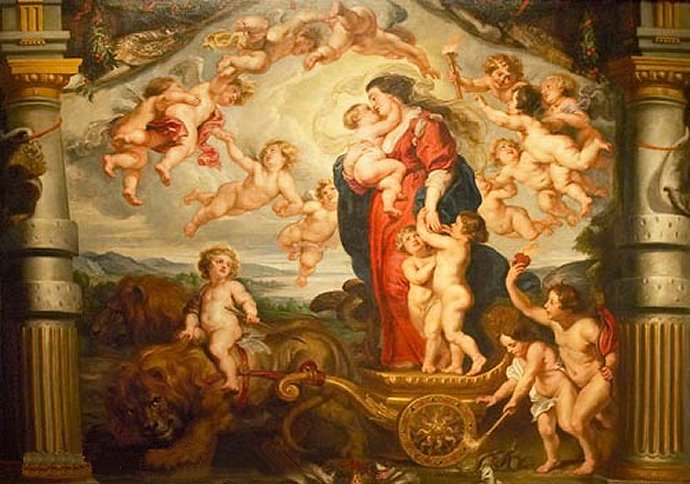Angels in Art - Putti
The Triumph of Divine Love, by Peter Paul Rubens 1625
by Lin Vertefeuille, December 2002
The top of the tapestry made from this cartoon has a cartouche titled, "Amor
Divinus." However, this painting is often referred to as Caritas, because the
central female figure is Charity. The Church since the Middle Ages determined that Charity
was the most, important of the three theological virtues: Hope, Faith and Charity. Their
interpretation of Charity was: Christ's love for us, our love of God "amor dei"
and our love of neighbor "amor proximi". Thomas Aquinas, author of the
"Corpus Christi" sequence, described Christ's Sacrifice celebrated in the
Eucharist as the "Sacrament of Love". This explains the painting's relevancy in
the Eucharistic theme of the Cycle. Appropriately Isabella Clara Eugenia commissioned the
tapestries for the Convent of the Poor Clare's celebration of the Feast of Corpus Christi.
The flaming heart of intense love of God and flaming arrows were attributes of Charity. In
the Baroque period Charity was depicted as "Virgo Lactens," Virgin Mary - the
traditional mother figure, wearing blue and red with three children, usually one suckling
at her breast. The two young figures by her side therefore are her children, not putti.
In this allegorical scene Putti are spirits of love used in a religious context. Three are
earth bound and twelve putti fly above Caritas forming a corona or halo. Eleven flying
putti are seen holding hands, the twelfth is behind Caritas. Some putti have birds' wings,
others have butterfly wings and one holds a burning torch - flame of our love for God.
This composition of a ring formed by putti holding hands was used in another painting by
Peter Paul Rubens, "The Exchange of Princesses" in the Medici Cycle. The three
terrestrial putti are wingless. One is holding an arrow (a symbol of love) and riding a
lion pulling the chariot. A chariot pulled by lions is a classical reference of Cybele,
earth mother. A putti stooping with an inverted torch kills two entwined snakes
representing sin and evil. Another raises a flaming heart of intense sacred love.
The triumph of Divine Love is one of group of three processional triumphs of
allegorical women Fides, Caritas and Ecclesia that are part of Rubens'
Eucharist Cycle. Rubens used putti in reggifestone decoration in three of our Eucharist
Cycle paintings: The Meeting of Abraham and Melchizedek, The Four Evangelists,
and The Defenders of the Eucharist. Putti with garlands of fruit are hanging the
fictive tapestries, creating the clever illusion of a tapestry within a tapestry.-

Sources:
Scribner, Charles III, The Triumph of the Eurcharist, Tapestries Designed by Rubens,
UlVlI Research Press, Ann Arbor, Michigan 1982 p. 65-67, 74-77.
Encyclopedia of Comparative Iconography, Fitzroy Dearborn Publishers, Chicago
1998 p. 914-915. '~
De Poorter, Nora, The Eurcharist Series I, II..Harvey Miller-Heyden and Son,
LOndon 1978 V1, V2 p. 169-171,210-211
Dictionary of Art, Macmillan Publishers Limited, London 1996 V.27 p. 287-302
Hall, James, Dictionary of Subjects and Symbols in Art, Westview Press, Boulder
Colorado 1974 p. 54, 89
ringlingdocents.org
|